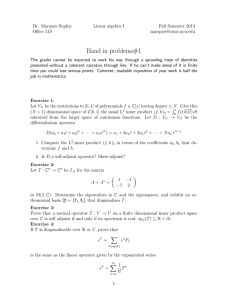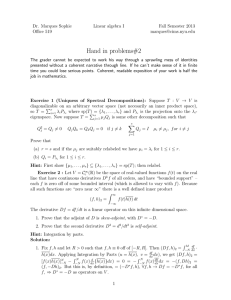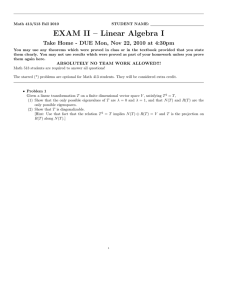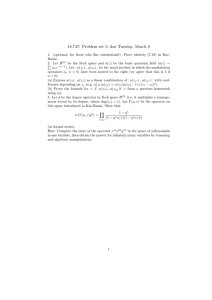Hand in problems#2
advertisement
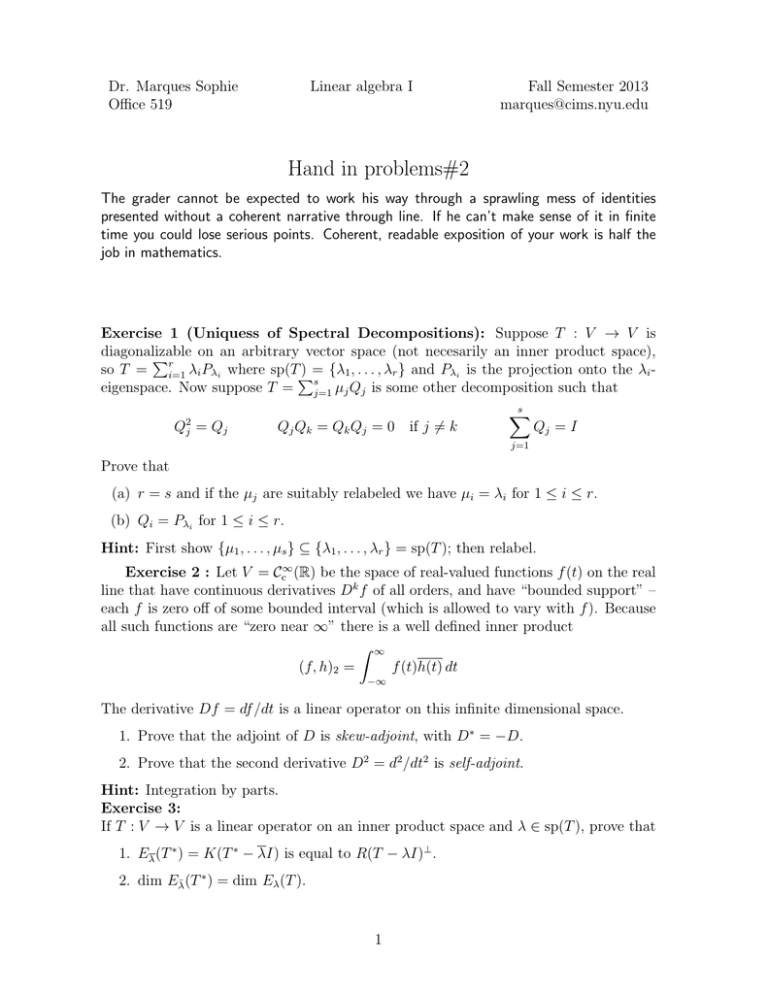
Dr. Marques Sophie
Office 519
Linear algebra I
Fall Semester 2013
marques@cims.nyu.edu
Hand in problems#2
The grader cannot be expected to work his way through a sprawling mess of identities
presented without a coherent narrative through line. If he can’t make sense of it in finite
time you could lose serious points. Coherent, readable exposition of your work is half the
job in mathematics.
Exercise 1 (Uniquess of Spectral Decompositions): Suppose T : V → V is
diagonalizable
on an arbitrary vector space (not necesarily an inner product space),
Pr
) = {λ1 , . . . , λr } and Pλi is the projection onto the λi so T = i=1 λi Pλi where sp(TP
eigenspace. Now suppose T = sj=1 µj Qj is some other decomposition such that
Q2j
= Qj
Qj Qk = Qk Qj = 0 if j 6= k
s
X
Qj = I
j=1
Prove that
(a) r = s and if the µj are suitably relabeled we have µi = λi for 1 ≤ i ≤ r.
(b) Qi = Pλi for 1 ≤ i ≤ r.
Hint: First show {µ1 , . . . , µs } ⊆ {λ1 , . . . , λr } = sp(T ); then relabel.
Exercise 2 : Let V = Cc∞ (R) be the space of real-valued functions f (t) on the real
line that have continuous derivatives Dk f of all orders, and have “bounded support” –
each f is zero off of some bounded interval (which is allowed to vary with f ). Because
all such functions are “zero near ∞” there is a well defined inner product
Z ∞
(f, h)2 =
f (t)h(t) dt
−∞
The derivative Df = df /dt is a linear operator on this infinite dimensional space.
1. Prove that the adjoint of D is skew-adjoint, with D∗ = −D.
2. Prove that the second derivative D2 = d2 /dt2 is self-adjoint.
Hint: Integration by parts.
Exercise 3:
If T : V → V is a linear operator on an inner product space and λ ∈ sp(T ), prove that
1. Eλ (T ∗ ) = K(T ∗ − λI) is equal to R(T − λI)⊥ .
2. dim Eλ̄ (T ∗ ) = dim Eλ (T ).
1
Exercise 4:
If m < n and the coordinate spaces Km , Kn are equipped with the standard inner
products, consider the linear operator
T : Km → Kn
T (x1 , · · · , xm ) = (x1 , · · · , xm , 0, · · · , 0)
This is an isometry from Km into Kn , with trivial kernel K(T ) = (0) and range R(T ) =
Km × (0) in Kn = Km ⊕ Kn−m .
1. Provide an explicit description of the adjoint operator T ∗ : Kn → Km and determine K(T ∗ ), R(T ∗ ).
2. Compute the matrices of [T ] and [T ∗ ] with respect to the standard orthonormal
bases in Km , Kn .
3. How is the action of T ∗ related to the subspaces K(T ), R(T ∗ ) in Km and R(T ), K(T ∗ )
in Kn ? Can you give a geometric description of this action?
Unitary operators can be described in several different ways, each with its own advantages in applications.
Exercise 5:
Let X = {e1 , . . . , en } be an arbitrary basis (not necessarily orthonormal) in a finite
dimensional inner product space V .
(a) Use induction on n to prove that there exist vectors Y = {f1 , . . . , fn } such that
(ei , fj ) = δij .
(b) Explain why the fj are uniquely determined and a basis for V .
Note: If the initial basis X is orthonormal then fi = ei and the result trivial; we are
interested in arbitrary bases in an inner product space.
Exercise 6 :
Let V be an inner product space and T a linear operator that is diagonalizable in the
ordinary sense, but not necessarily orthogonally diagonalizable. Prove that
(a) The adjoint operator T ∗ is diagonalizable. What can you say about its eigenvalues
and eigenspaces?
(b) If T is orthogonally diagonalizable so is T ∗ .
Hint: If {ei } diagonalizes T what does the “dual basis” {fj } of Exercise 5 do for T ∗ ?
Exercise 7: Here V = R3 and f1 , f2 , f3 ∈ V ∗ are the linear functionals fk : V → R
given by (∗∗) f1 (x, y, z) = x − 2y, f2 (x, y, z) = x + y + z and f3 (x, y, z) = y − 3z;
1. Prove Y = {f1 , f2 , f3 } is a basis in V ∗ .
2. Find a basis X = {e01 , e02 , e03 } ⊆ V whose dual basis X ∗ in V is equal to Y.
2
